Mathematical Analysis and Optimal Control of Giving up the Smoking Model
Abstract
In this study, we are going to explore mathematically the dynamics of giving up smoking behavior. For this purpose, we will perform a mathematical analysis of a smoking model and suggest some conditions to control this serious burden on public health. The model under consideration describes the interaction between the potential smokers (P), the occasional smokers (L), the chain smokers (S), the temporarily quit smokers , and the permanently quit smokers . Existence, positivity, and boundedness of the proposed problem solutions are proved. Local stability of the equilibria is established by using Routh–Hurwitz conditions. Moreover, the global stability of the same equilibria is fulfilled through using suitable Lyapunov functionals. In order to study the optimal control of our problem, we will take into account a two controls’ strategy. The first control will represent the government prohibition of smoking in public areas which reduces the contact between nonsmokers and smokers, while the second will symbolize the educational campaigns and the increase of cigarette cost which prevents occasional smokers from becoming chain smokers. The existence of the optimal control pair is discussed, and by using Pontryagin minimum principle, these two optimal controls are characterized. The optimality system is derived and solved numerically using the forward and backward difference approximation. Finally, numerical simulations are performed in order to check the equilibria stability, confirm the theoretical findings, and show the role of optimal strategy in controlling the smoking severity.
1. Introduction
Smoking is a behavior in which a substance is heated or burned, and the derived smoke is breathed through the mouth or the nose and goes directly to the lungs. The active substances of the smoke are rapidly transmitted from the lungs to the bloodstream and therefore to the brain where they operate. The most common smoking substance is known as tobacco which is consumed by nearly 1.3 billion smokers worldwide [1]. More than 9% of all deaths are related to tobacco consumption [2], making the burden of smoking a global health priority. Smoking is one of the main risk factors of many noncommunicable diseases such as diabetes, cancer, cardiovascular, and chronic respiratory diseases [3–8].
The reversion to the smoking phenomenon is highlighted in this model by the parameter α which represents the ratio of temporarily quit smokers who start to smoke again, while η is the portion of quitters who quit smoking permanently. The flowchart of our suggested smoking model is illustrated in Figure 1. Our main interest is to study the equilibria stability of model (2) and to study the role of the optimal control strategy in reducing the number of smokers. For this last reason, we will introduce two controls; the first will represent the government prohibition of smoking in public areas, while the second control will symbolize the educational campaigns and the increase of cigarette cost. It will worthy to notice that the optimal control strategy have shown its efficiency in controlling many diseases such as tuberculosis and COVID-19 [15, 16]. Also, the optimal control has been studied in some fractional mathematical models [17]. Finally, as applications of many fractional derivatives on smoking modelling issues, we can cite [18–23].
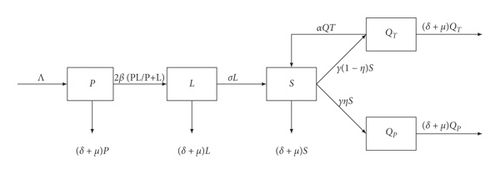
Different studies on smoking [16] have shown the clear impact of tobacco consumption on the rapid deterioration of health in COVID-19 patients. In fact, smokers are more vulnerable to COVID-19 because they already have respiratory problems, which considerably increase the risk that their condition worsens more quickly than nonsmokers. Hence, our main ambition is to check the role of governement of prohibition of smoking in public area, education campaign, and the increase of cigarette cost in controlling the severity of the smokers’ addiction.
This paper is organized as follows. In Section 2, we will establish the wellposedness of our suggested mathematical model by proving the existence, positivity, and boundedness of solutions. We fulfilled the mathematical analysis of the model, by proving the local and global stability of the equilibria in Sections 3 and 4. The optimization analysis of our model is given in Section 5; in Section 6 an appropriate numerical algorithm is constructed and some numerical simulations are given. The numerical results will show the importance of the optimal control in reducing the smokers’ addiction. In Section 7, we will give concluding remarks.
2. The Wellposedness Result and Smokers’ Generation Number
2.1. The Wellposedness Result
Let be the Banach space of continuous functions mapping ℝ+ into ℝ5 with the topology of uniform convergence. By using the fundamental theory of functional differential equations [24], we prove that there exists a unique local solution of system (2) with initial data . The following proposition guarantees that this solution exists globally.
Proposition 1. The solution of the studied model (2) remains positive and bounded for all t ≥ 0. Moreover, we have
Proof. The solution P(t) is nonnegative, for all t ≥ 0. Supposing the contrary, let t0 > 0 be the first time such that P(t0) = 0 and . From the first equation of system (2), we have , which leads a contradiction. Similar proofs show the positivity of L(t), S(t), , and , for all t ≥ 0. Indeed, according to system (2), we have , , , and . This completes the proof of positivity.
About boundedness, let the total population .
Since 0 < e−(δ + μ)t ≤ 1, for all t ≥ 0, we conclude that N(t) ≤ (Λ/(δ + μ)) + N(0).
2.2. The Smokers’ Generation Number
The smokers’ generation number is defined as the average number of new smokers resulting from one smoker, in a population consisting of potential smokers only. We use the next generation matrix FV−1 to calculate the smokers’ generation number R0 [25].
3. The Problem Equilibria and Local Stability
3.1. The Smoking Problem Equilibria
- (i)
The smoking-free equilibrium state is E0((Λ/(δ + μ)), 0,0,0,0).
- (ii)
The smoking-present equilibrium point is such that
(10)
3.1.1. Local Stability of the Smoking-Free Equilibrium
The local stability of the smoking-free equilibrium E0((Λ/(δ + μ)), 0,0,0,0) is given by the following result.
Proposition 2.
- (1)
If R0 < 1, then the smoking-free equilibrium, E0, is locally asymptotically stable.
- (2)
If R0 > 1, then E0 is unstable.
We conclude that E0 is locally asymptotically stable when R0 < 1.
3.1.2. Local Stability of the Smoking-Present Equilibrium
The first eigenvalue of the above characteristic polynomial is ξ1 = −(δ + μ) < 0; the second eigenvalue is ξ2 = −(2βq2 + δ + μ) < 0.
If R0 > 1, then [(2βq2 + δ + μ)(σ + δ + μ) − 2β(δ + μ)p2] > 0; consequently, a1 > 0.
Thus, it is easy to verify that a2 > 0, a1a2 − a3 > 0, and a3 > 0. Then, by application of Routh–Hurwitz theorem, the other eigenvalues, ξ3, ξ4, and ξ5, have negative real parts.We conclude that E∗ is locally asymptotically stable in case when R0 > 1.
4. The Smoking Problem Global Stability Analysis
4.1. Global Stability of the Smoking-Free Equilibrium
Theorem 1. If R0 ≤ 1, then the smoking-free equilibrium E0 is globally asymptotically stable.
If R0 ≤ 1, then ; consequently, according to the Lyapunov theorem, the smoking-free equilibrium E0 is globally asymptotically stable.
4.2. Global Stability of the Smoking-Present Equilibrium
Theorem 2. If R0 > 1, then the smoking-present equilibrium point E∗ is globally asymptotically stable.
Since R0 > 1, we have that R0 − 1 > 0. Consequently, .
We conclude that the smoking-present equilibrium point E∗ is globally asymptotically stable when R0 > 1.
5. Optimal Control of Smoking Problem
5.1. The Smoking Optimization Problem
The first control u1 represents the government prohibition of smoking in public area, while the second control u2 symbolizes the education campaign and the increase of cigarette cost. The aim of the first control is to reduce the contact between nonsmokers and smokers; the role of the second control is to prevent occasional smokers to become chain smokers. Since the two controls represent the effectiveness of each strategy, we will have the fact that ui ∈ [0,1].
5.2. The Smoking Optimality System
The optimality system is summarized by the following result.
Proposition 3. For any solution of the smoking optimization problem, there exist the adjoint variables, ϕ1, ϕ2, ϕ3, ϕ4, and ϕ5, satisfying the system of equations
In addition, the optimal control is given by
Proof. The five adjoint equations and the transversality conditions can be obtained via Pontryagin’s minimum principle [26] such that
Simple calculations lead to
The two optimal controls and can be found from the following optimality conditions:
However, we have
Since the two controls belong to the interval [0,1], we will have
In addition, we have
6. Numerical Simulations
In order to solve numerically the optimization system, we will use the classical discretized scheme based on forward and backward finite-difference approximation scheme [28–30]. The numerical method will be implemented under Algorithm 1. The parameters values of our numerical simulations are given in Table 1.
-
Algorithm 1:
-
Step 1 (initial conditions):
-
P0, L0, S0, , , , .
-
.
-
Step 2 (numerical solving):
-
fori = 0, …, n − 1, do:
-
,
-
,
-
,
-
,
-
,
-
-
,
-
,
-
,
-
,
-
-
,
-
,
-
,
-
end for
-
Step 3 (the solution and optimal controls):
-
fori = 1, …, n, write
-
,
-
.
-
end for
The smoking-free equilibrium stability result is illustrated numerically in Figure 2. In fact, we clearly see that the number of potential smokers increase and reach its maximum value. However, the other components of our smoking problem representing occasional smokers, chain smokers, temporarily quit smokers, and permanently quit smokers vanish. Within the used parameters in this figure (see Table 1), we can easily calculate the smokers’ generation number, R0 = 0.119952, which means that this number is less than unity, and we have confirmation, from our theoretical findings, that the smoking-free equilibrium is stable. Moreover, we observe that all the curves converge toward the smoking-free equilibrium Ef = (3.12, 0,0,0,0) which means that our numerical result supports the theoretical result concerning the stability of the first steady state.
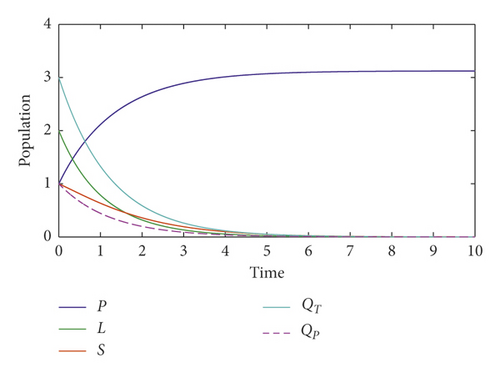
On the contrary, the smoking-present equilibrium stability is represented in Figure 3. Here, all the smoking problem compartments remain at strictly positive levels. From Table 1, we can calculate the smokers’ generation number relative to this figure, R0 = 1.88. Since it is greater than unity, we have confirmation from our theoretical results that the smoking-present equilibrium is stable. Both the numerical and the theoretical results agree about the stability of the smoking-present equilibrium. From this same figure, we see the convergence of the different curves toward the smoking-present equilibrium E∗ = (5.81, 5.13, 2.36, 1.43, 4.48) which means this second steady state can be found numerically or calculated theoretically. We conclude that the local and global theoretical results concerning the stability of the smoking-free and the smoking-present equilibria are in good agreement with our numerical results.
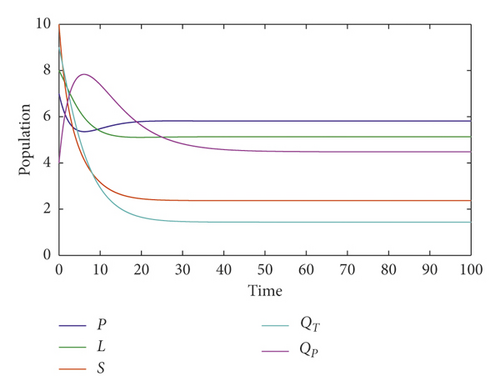
Our third numerical result concerns the comparison between the model with control strategy and the model without any control. Indeed, Figure 4 shows the evolution of potential smokers, occasional smokers, chain smokers, temporarily quit smokers, permanently quit smokers, and the two controls as the function of time. We clearly observe that, with control strategy, we will have more potential smokers than without control measures. Also, it is clearly seen that, with control measures, a significant reduce of occasional and chain smokers is observed. This means the roles of control strategies are to reduce the number of occasional and chain smokers which can lead to save many lives in smoking population. Besides, with control strategy, we observe that, without any control strategy, the curves representing the different smoking compartment converge toward E∗ = (5.81, 5.13, 2.36, 1.43, 4.48). However, with taking significant control measures, those curves converge toward which confirms the role of control in reducing the smoking habit. In addition, we remark from the two controls’ behavior that we should give more importance to the first control than the second. It is also observed that the two controls should be also maintained at a constant level in order to have the desired good result.
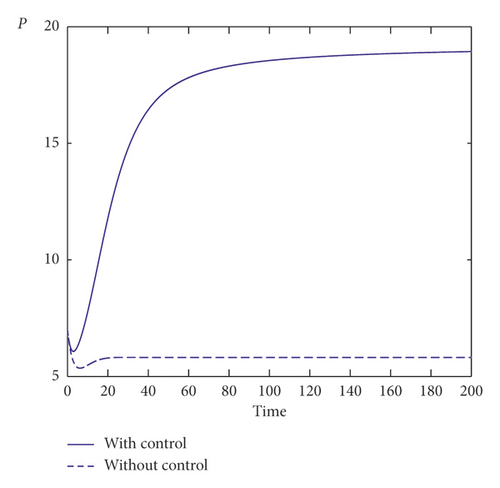
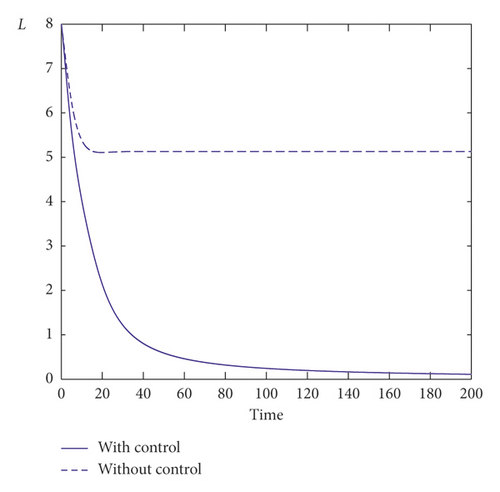
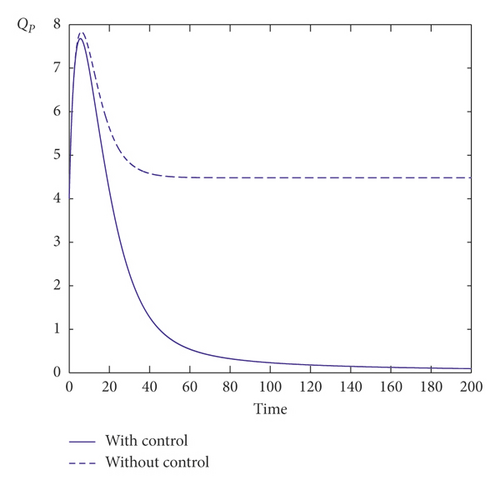

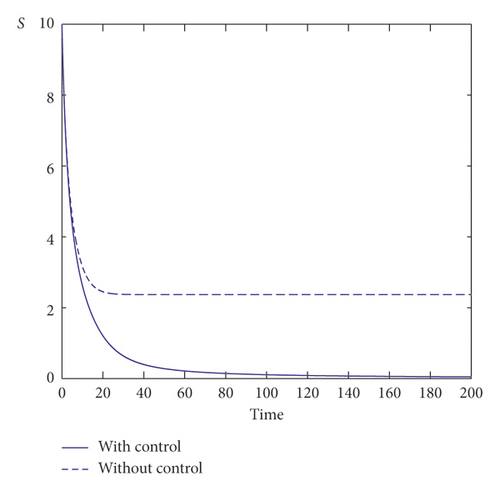
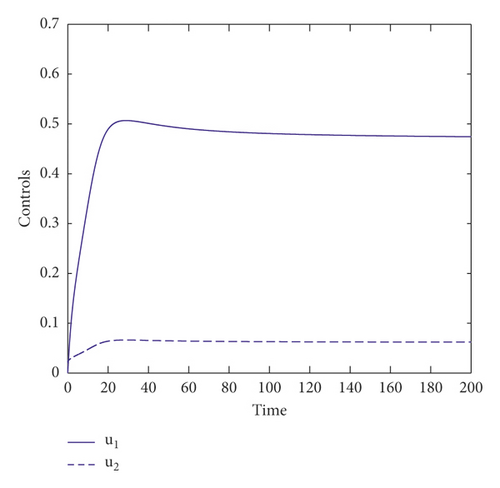
7. Conclusion
We have studied in this paper mathematically and numerically the dynamics of giving up smoking behavior. The suggested smoking model consists of a system of five differential equations representing the potential smokers, the occasional smokers, the chain smokers, the temporarily quit smokers, and the permanently quit smokers. We have established the wellposedness result of our smoking problem by proving the existence, positivity, and boundedness of the smoking problem solution. Both the equilibria local and the global stability results are fulfilled. To study the role of control measures on our smoking problem dynamics, two different controls are introduced to the model. The role of the first control is to reduce the contact between nonsmokers and smokers, while the objective of the second is to prevent occasional smokers to become chain smokers. The existence and the characterization of the two optimal controls are discussed by using the Pontryagin minimum principle. The optimality system is solved numerically using the classical forward and backward difference numerical scheme. It was established that the numerical simulations concerning the stability of the smoking-free and the smoking-present equilibria are in good agreement with the local and global theoretical results. Moreover, the numerical results confirm the important role of control measures in reducing the number of occasional and chain smokers which may save significant number of lives in the smoking population.
Conflicts of Interest
The authors declare that there are no conflicts of interest regarding the publication of this study.
Open Research
Data Availability
No data were used to support this study.




